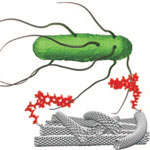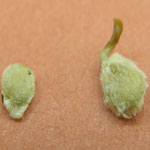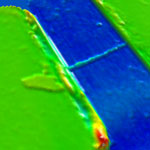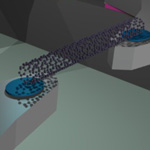Showing Spotlights 137 - 144 of 318 in category All (newest first):
 A newly published antibacterial activity mechanism study demonstrates how a single walled carbon nanotube (SWCNT) kills bacteria by the physical puncture of bacterial membranes. The nanotubes would constantly attack the bacteria in solution, degrading the bacterial cell integrity and causing the cell death. This work elucidates several factors controlling the antibacterial activity of pristine SWCNTs and provides an insight in their toxicity mechanism. With regard to carbon nanotubes, in early toxicological studies, researchers obtained confounding results - in some studies nanotubes were toxic; in others, they were not. The apparent contradictions were actually a result of the materials that the researchers were using.
A newly published antibacterial activity mechanism study demonstrates how a single walled carbon nanotube (SWCNT) kills bacteria by the physical puncture of bacterial membranes. The nanotubes would constantly attack the bacteria in solution, degrading the bacterial cell integrity and causing the cell death. This work elucidates several factors controlling the antibacterial activity of pristine SWCNTs and provides an insight in their toxicity mechanism. With regard to carbon nanotubes, in early toxicological studies, researchers obtained confounding results - in some studies nanotubes were toxic; in others, they were not. The apparent contradictions were actually a result of the materials that the researchers were using.
Nov 10th, 2009
 New research reported this week has now established an industrially relevant process for assembling carbon nanotubes that allows them to efficiently be made into fibers, coatings and films - the basic forms of material that can be used in engineering applications. The most common of processing nanotubes into neat fibers - apart from 'dry' methods where they are spun directly into ropes and yarns - are 'wet' methods where CNTs are dispersed into a liquid and solution-spun into fiber. Currently, these processes yield fibers whose properties are not sufficiently close to optimal. Successful carbon nanotube assembly begins with control of dispersion and phase behavior and requires a scientific understanding of flow, colloidal interactions and solvent removal.
New research reported this week has now established an industrially relevant process for assembling carbon nanotubes that allows them to efficiently be made into fibers, coatings and films - the basic forms of material that can be used in engineering applications. The most common of processing nanotubes into neat fibers - apart from 'dry' methods where they are spun directly into ropes and yarns - are 'wet' methods where CNTs are dispersed into a liquid and solution-spun into fiber. Currently, these processes yield fibers whose properties are not sufficiently close to optimal. Successful carbon nanotube assembly begins with control of dispersion and phase behavior and requires a scientific understanding of flow, colloidal interactions and solvent removal.
Nov 5th, 2009
 Due to their unique structural and electrical properties, carbon nanotubes have been extensively investigated as promising catalyst supports to improve the efficiency of direct ethanol/methanol fuel cells. CNTs have a significantly higher electronic conductivity and an extremely higher specific surface area in comparison with the most widely-used Vulcan XC-72R carbon support. Several approaches, such as electrochemical reduction, electroless deposition, spontaneous reduction, sonochemical technique, microwave-heated polyol process, and nanoparticle decoration on chemically oxidized nanotube sidewalls, have been reported to form CNT-supported platinum catalysts. Some remarkable progress has been made in synthesis techniques; however, pioneering breakthroughs have not been made yet in terms of cost-effectiveness catalyst activity, durability, and chemical-electrochemical stability. Nanotechnology researchers in the U.S. have now discovered that platinum nanoparticles selectively grow on carbon nanotubes in accordance with single-stranded DNA locations.
Due to their unique structural and electrical properties, carbon nanotubes have been extensively investigated as promising catalyst supports to improve the efficiency of direct ethanol/methanol fuel cells. CNTs have a significantly higher electronic conductivity and an extremely higher specific surface area in comparison with the most widely-used Vulcan XC-72R carbon support. Several approaches, such as electrochemical reduction, electroless deposition, spontaneous reduction, sonochemical technique, microwave-heated polyol process, and nanoparticle decoration on chemically oxidized nanotube sidewalls, have been reported to form CNT-supported platinum catalysts. Some remarkable progress has been made in synthesis techniques; however, pioneering breakthroughs have not been made yet in terms of cost-effectiveness catalyst activity, durability, and chemical-electrochemical stability. Nanotechnology researchers in the U.S. have now discovered that platinum nanoparticles selectively grow on carbon nanotubes in accordance with single-stranded DNA locations.
Oct 28th, 2009
 Researchers have developed a self-sensing nanotechnology composite material for traffic monitoring by using piezoresistive multi-walled carbon nanotubes as an admixture. In experiments, they studied the response of the piezoresistive properties of this composite to compressive stress and they investigated with vehicular loading experiments the feasibility of using self-sensing CNT/cement composite for traffic monitoring. This nanocomposite cement has great potential for traffic monitoring use such as in vehicle detection, weigh-in-motion measurement and vehicle speed detection. An interesting aspect of this work is that, from the eventual traffic application's point of view, the pavement itself would become the traffic detection, thus eliminating the need for separate traffic flow detection sensors.
Researchers have developed a self-sensing nanotechnology composite material for traffic monitoring by using piezoresistive multi-walled carbon nanotubes as an admixture. In experiments, they studied the response of the piezoresistive properties of this composite to compressive stress and they investigated with vehicular loading experiments the feasibility of using self-sensing CNT/cement composite for traffic monitoring. This nanocomposite cement has great potential for traffic monitoring use such as in vehicle detection, weigh-in-motion measurement and vehicle speed detection. An interesting aspect of this work is that, from the eventual traffic application's point of view, the pavement itself would become the traffic detection, thus eliminating the need for separate traffic flow detection sensors.
Oct 9th, 2009
 In their effort to develop a fast, sensitive, selective, inexpensive, and easy-to-use method for detecting and quantifying pathogenic bacterial cells, researchers in Spain have now demonstrated a carbon nanotube based potentiometric biosensor for selectively detecting one single colony-forming unit of the bacterium Salmonella Typhi in close to real time. The most important strength of this biosensor is that simple positive/negative tests can be carried out in real zero-tolerance conditions and without cross reaction with other types of bacteria. The ease with which measurements are taken in potentiometric analysis opens the door to greater simplicity in microbiological analysis.
In their effort to develop a fast, sensitive, selective, inexpensive, and easy-to-use method for detecting and quantifying pathogenic bacterial cells, researchers in Spain have now demonstrated a carbon nanotube based potentiometric biosensor for selectively detecting one single colony-forming unit of the bacterium Salmonella Typhi in close to real time. The most important strength of this biosensor is that simple positive/negative tests can be carried out in real zero-tolerance conditions and without cross reaction with other types of bacteria. The ease with which measurements are taken in potentiometric analysis opens the door to greater simplicity in microbiological analysis.
Oct 5th, 2009
 To what degree nanoparticles are uptaken by plants and what their effect is on plant development is an important issue in determining the environmental impact of nanomaterials. Previously we have covered several research projects that have begun to explore nanotechnology's impact on major food crops and some of them have demonstrated quite a negative impact. But some research results also show a possible positive effect, like a recent study that demonstrates that carbon nanotubes (CNTs) can dramatically accelerate the germination and growth of tomato seeds. Work like this contributes to an important body of interdisciplinary research where nanotechnology, plant biology and biotechnology converge to open new perspectives for solving some of the important challenges of our times such as increased food and biofuel production.
To what degree nanoparticles are uptaken by plants and what their effect is on plant development is an important issue in determining the environmental impact of nanomaterials. Previously we have covered several research projects that have begun to explore nanotechnology's impact on major food crops and some of them have demonstrated quite a negative impact. But some research results also show a possible positive effect, like a recent study that demonstrates that carbon nanotubes (CNTs) can dramatically accelerate the germination and growth of tomato seeds. Work like this contributes to an important body of interdisciplinary research where nanotechnology, plant biology and biotechnology converge to open new perspectives for solving some of the important challenges of our times such as increased food and biofuel production.
Sep 29th, 2009
 The degree of mobility of a semiconductor, i.e. how well it conducts, is crucial to the effectiveness of nanoelectronic devices. Mobility determines the carrier velocity, and hence switching speed, in FETs. Researchers have determined that the theoretical mobility of an individual single-walled carbon nanotube is about 1000 times higher than any other known semiconductor. However, practical applications would require massive manufacturing of large scale nanoelectronic devices. Despite progress being made with integrating individual nanotubes in lab environments, many of today's nanomanufacturing techniques for nanoelectronic devices rely on the use of 'carbon nanotube network films' comprised of multiple carbon nanotubes. The major problem here is that the electronic properties of CNT network films are usually very poor. Researchers in South Korea have now developed a powerful strategy to solve these fundamental problems simply by controlling the connectivity of nanotube/nanowire networks.
The degree of mobility of a semiconductor, i.e. how well it conducts, is crucial to the effectiveness of nanoelectronic devices. Mobility determines the carrier velocity, and hence switching speed, in FETs. Researchers have determined that the theoretical mobility of an individual single-walled carbon nanotube is about 1000 times higher than any other known semiconductor. However, practical applications would require massive manufacturing of large scale nanoelectronic devices. Despite progress being made with integrating individual nanotubes in lab environments, many of today's nanomanufacturing techniques for nanoelectronic devices rely on the use of 'carbon nanotube network films' comprised of multiple carbon nanotubes. The major problem here is that the electronic properties of CNT network films are usually very poor. Researchers in South Korea have now developed a powerful strategy to solve these fundamental problems simply by controlling the connectivity of nanotube/nanowire networks.
Aug 4th, 2009
 The fundamental issue of large-scale carbon nanotube (CNT) device fabrication remains the biggest challenge for effective commercialization of CNT-based nanoelectronic devices. For CNT electronics to become a reality requires manufacturing techniques to simultaneously and reproducibly fabricate a very large number of such devices on a single chip, each accessible individually for electronic transport. Conventional nanotube growth and device fabrication techniques using chemical vapor deposition or spin-casting are unable to achieve this, due to a lack of precise control over nanotube positioning and orientation. New work conducted at Tel Aviv University utilizes the CVD growth of CNTs over pillar-patterned silicon substrates to facilitate the formation of devices with taut and aligned CNTs grown exclusively at desired positions with built-in electrical contacts.
The fundamental issue of large-scale carbon nanotube (CNT) device fabrication remains the biggest challenge for effective commercialization of CNT-based nanoelectronic devices. For CNT electronics to become a reality requires manufacturing techniques to simultaneously and reproducibly fabricate a very large number of such devices on a single chip, each accessible individually for electronic transport. Conventional nanotube growth and device fabrication techniques using chemical vapor deposition or spin-casting are unable to achieve this, due to a lack of precise control over nanotube positioning and orientation. New work conducted at Tel Aviv University utilizes the CVD growth of CNTs over pillar-patterned silicon substrates to facilitate the formation of devices with taut and aligned CNTs grown exclusively at desired positions with built-in electrical contacts.
Jul 23rd, 2009
 A newly published antibacterial activity mechanism study demonstrates how a single walled carbon nanotube (SWCNT) kills bacteria by the physical puncture of bacterial membranes. The nanotubes would constantly attack the bacteria in solution, degrading the bacterial cell integrity and causing the cell death. This work elucidates several factors controlling the antibacterial activity of pristine SWCNTs and provides an insight in their toxicity mechanism. With regard to carbon nanotubes, in early toxicological studies, researchers obtained confounding results - in some studies nanotubes were toxic; in others, they were not. The apparent contradictions were actually a result of the materials that the researchers were using.
A newly published antibacterial activity mechanism study demonstrates how a single walled carbon nanotube (SWCNT) kills bacteria by the physical puncture of bacterial membranes. The nanotubes would constantly attack the bacteria in solution, degrading the bacterial cell integrity and causing the cell death. This work elucidates several factors controlling the antibacterial activity of pristine SWCNTs and provides an insight in their toxicity mechanism. With regard to carbon nanotubes, in early toxicological studies, researchers obtained confounding results - in some studies nanotubes were toxic; in others, they were not. The apparent contradictions were actually a result of the materials that the researchers were using.
 Subscribe to our Nanotechnology Spotlight feed
Subscribe to our Nanotechnology Spotlight feed





